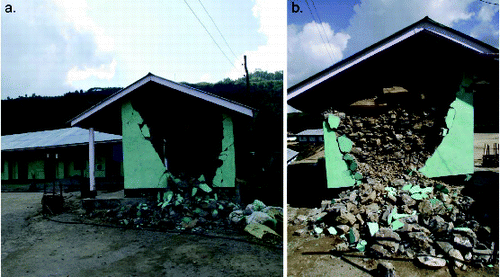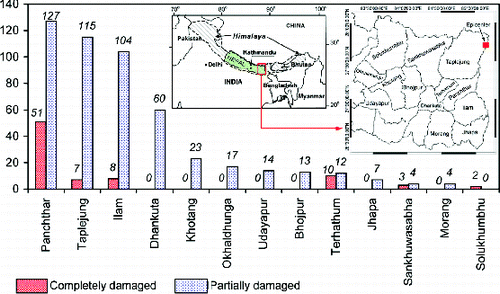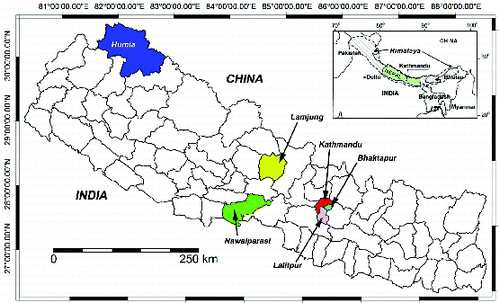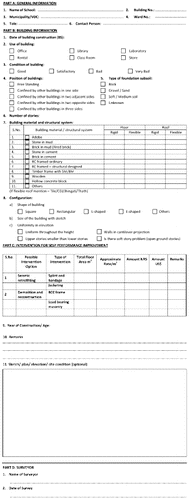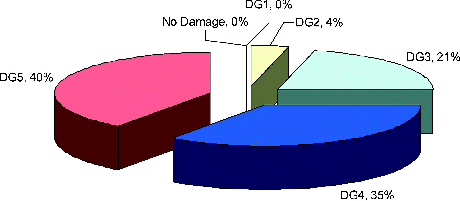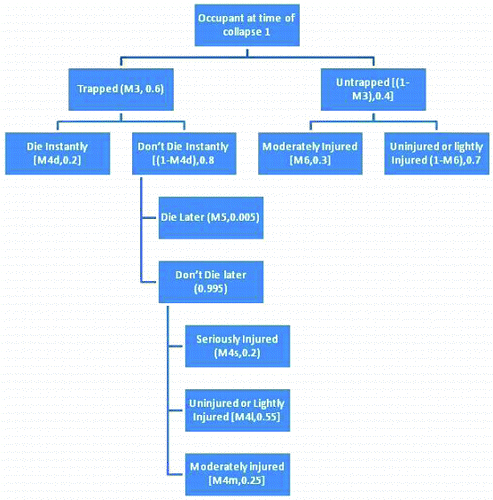Abstract
Earthquakesare one of the most significant natural hazards in Nepal and there is a long history of destructive earthquakes in the region. Despite the risk of earthquake disasters, however, school construction practice in Nepal has largely ignored the issues of structural safety. Most schools are built without following proper design guidelines. As an effective tool to reduce earthquake disaster risk in the public schools of Nepal, the Public School Earthquake Safety Program was recently initiated in Nepal. In this program, more than 1000 public schools from six districts of Nepal were evaluated for earthquake safety, and various awareness raising and retrofitting programs were implemented. This paper describes the program features, extent of community participation, retrofitting processes and lessons learned while implementing the earthquake safety program. It also demonstrates how school earthquake safety programs ultimately increase the seismic safety of the entire community in the Himalayan regions.
1. Introduction
Nepal has a long history of destructive earthquakes (Rana Citation1935; Dunn et al. Citation1939; Chitrakar & Pandey Citation1986; Bilham Citation2001; Wyss Citation2005). From east to west, the sequence includes the 1905 Kangra earthquake (Ms ∼ 7.8), the 1934 Bihar–Nepal earthquake (Mw = 8.1) and the 1950 Assam earthquake (Mw ∼ 8.6). The Sikkim/Nepal border earthquake of September 18, 2011 was the latest earthquake (6.9 Richter magnitude) in Nepal.
In this century alone, over 11,000 people have lost their lives in four major earthquakes. A study of the seismic record of the region suggests that earthquakes producing a shaking level of IX or more in the Modified Mercalli Intensity (MMI) scale occur approximately every 75 years, while smaller ones occur more frequently. Earthquakes are thus an unavoidable part of Nepal's history, and based on the occurrence frequency, a major earthquake is likely to hit the region in the near future (Ambraseys & Bilham Citation2000; JICA Citation2002). Despite this knowledge of seismic history and the disaster risks, public awareness on earthquake hazard risks was minimal until a decade ago. Only after a massive destruction and loss of 721 human lives due to the Udayapur earthquake (Gupta Citation1988) of 1988 (Mw ∼ 6.6) the need for an organized approach towards earthquake risk management was realized and several innovative initiatives on earthquake disaster risk management were commenced. Nepal is ranked the 11th worst in terms of relative vulnerability to earthquake disasters (BCPR Citation2004). The World Bank (Arnold et al. Citation2005) study identifies Nepal as a disaster hotspot, while the Global Earthquake Safety Initiative Pilot Project labels the Kathmandu valley as the most at-risk city in terms of potential death in an earthquake disaster (GHI and UNCRD Citation2001). If an earthquake of the same magnitude as the 1934 earthquake hits the Kathmandu valley again, it is estimated that more than 100,000 people will be killed. The loss estimation () clarifies the extent of the problem faced by the Kathmandu valley. In this estimation, only the cases of MMI IX level were used due to unavailability of other parameters.
Table 1. Earthquake damage scenario of Kathmandu valley with consideration of 2010 demographic conditions in the valley. Detailed procedure of this table is available in Guragain et al. Citation(2008).
These data clearly suggest that the earthquake disaster scenario of Nepal is very alarming and it is of utmost importance to prepare for an upcoming earthquake disaster.
When earthquake vulnerability of various public infrastructures of Nepal is talked of, public schools, both the buildings and their occupants, face great risk of earthquake disasters (NSET Citation2000 and Shrestha Citation2001). This is because a majority of the school buildings, even those constructed in recent years, have not followed any technical advice or guidance from trained engineers during the design or construction supervision. A majority of the school buildings are constructed with load-bearing masonry wall system, mostly brick masonry in flat terrains of the Terai and valleys and stone masonry in the hills and mountains. There are only few buildings constructed of timber (in Terai), adobe (high mountains and in Terai) and other construction materials. Mud is used as mortar in most cases, although cement-based construction is prevalent in urban and semi-urban areas. A visibly increasing trend in the use of RCC (reinforced cement concrete)-framed construction was found principally in the urban or the urbanizing areas, especially in the neighbourhood of road network. Despite the risk of earthquake disasters, the school construction practice in Nepal has largely ignored the issues of structural safety, especially in terms of structural design. Most of the school buildings were/are built without following proper design guidelines, which necessitates the implementation of an effective tool for the reduction of earthquake disaster risks in the public schools of Nepal.
High vulnerability of schools was particularly evidenced during the 1988 Udayapur earthquake in Eastern Nepal. About 6000 school buildings were destroyed in this disaster event, but fortunately, it was during non-school hours. Such a massive damage to the school infrastructure disrupted the community and affected approximately 300,000 children for several months. The same situation occurred again after the latest Sikkim/Nepal border earthquake of September 18, 2011 (Raghukanth et al. Citation2012; Rai et al. Citation2012). Many schools in Eastern Nepal were damaged (). Most of the completely damaged school buildings () during this earthquake were stone and brick-in-mud type buildings, whereas the partially damaged buildings were brick masonry with cement mortar, RCC-framed structures and steel frame structures with walls of stone masonry with cement mortar. The partially damaged state refers mainly to cracks on walls, partial collapse of wall in one or two sides of the buildings, collapse of cement mortar on walls and so on. These partially damaged buildings were recovered within a few weeks and the schools were run smoothly.
All this recent damage information suggests that the school buildings in Nepal are at high risk of damage during an earthquake event. Therefore, the main objective of this paper is to highlight the school earthquake safety program (SESP), currently being implemented in Nepal, and to provide a comprehensive information of this program. The paper also introduces some initiatives and pilot works undertaken for the earthquake safety programs in schools of Nepal and also highlights program progress and recent deliverable programs.
2. Why public schools for earthquake safety program
Nepalese education system can be classified into two main categories: school education (i.e. 10 years of education) and higher education (i.e. post-school or college education). The school education includes primary level from grade 1 to 5, lower secondary level from grade 6 to 8 and secondary level from grade 9 to 10. In most of the urban areas, however, private schools provide education from grade 1 to 10, while in rural and sub-urban areas the public schools are the main educational centres that provide compulsory education from grade 1 to 12, including two years of post-school education. Broadly, the schools in Nepal () belong to one of the following four categories in terms of ownership and funding.
Community-aided schools: fully supported by the government for the teachers’ salaries and other operational costs.
Community-managed schools: fully supported by the government for the teachers’ salaries and other operational costs, but their management responsibility is undertaken by the community.
Community-unaided schools: either get partial support or no support from the government.
Private/institutional schools: supported by the parents and trustees.
Table 2. Number of schools in different ecological belts (Data source: Department of Education).
In addition to the above categories, there are separate groups of religious schools, such as (1) Madarsa (Muslim religion), (2) Gumba/Vihar (Buddhist religion) and (3) Ashram/Gurukul (Hindu religion).
Public schools are operated through the government and classified as community-aided, community-managed and community-unaided. The management of these schools lies under the local community through the government support. On the other hand, private schools in Nepal are owned by private sector entities and are registered under the Company Act of Nepal and they must receive an approval from the District Education Office (DEO) for their operation. Religious schools are managed and operated by different religious organizations. They are registered under the DEO and are recognized by the government. Only some but not all of these schools receive financial support from the government.
In most cases, public schools in Nepal are the centre of social and cultural life, especially in rural and sub-urban areas. During the post-disaster period, public school buildings can even serve as emergency shelters. Usually, they have playgrounds, which can be used for shelter tents or emergency medical services after an earthquake disaster event. Moreover, the loss suffered by a community due to the collapse of a school building is psychologically much greater than the loss due to the collapse of any other buildings.
Schools play a crucial role after an earthquake disaster in helping the community get back to normal state. Since schools are typically well distributed throughout the neighbourhoods, they are an ideal location to provide shelters for homeless, medical clinics and other emergency functions. Functioning of a school provides a feeling of normalcy to the community, helping people to get back on their feet after a disaster event.
Schools are also particularly tractable for earthquake safety programs. School structures are typically very simple and relatively small, unlike other critical facilities. Therefore, instead of constructing new school buildings with an earthquake-resistant concept, retrofitting the existing school buildings are economically feasible and technically suitable. Also, by raising awareness in the schools, an entire community can be accessed as the lessons trickle down to parents, relatives and friends.
3. Assessment of public school buildings
The study was focused on understanding the typology of the school buildings. Therefore, representative districts, namely three districts of the Kathmandu valley (i.e. Kathmandu, Lalitpur and Bhaktapur), Lamjung, Nawalparasi and Humla were chosen as the sampling areas (). These districts represent different geomorphological and socio-economical environments of Nepal: Kathmandu valley is the capital of Nepal; Lamjung is the Lesser Himalayan region; Nawalparasi represents the Terai region and Humla lies in the Higher Himalayan region. The Kathmandu valley has many infrastructural facilities with the highest population density, whereas Lamjung and Nawalparasi have nearly the same population density and similar economical and infrastructural facilities. Humla is one of the least developed districts of Nepal with very low population density and infrastructural facilities as it does not even have a direct road link with other parts of the nation.
To assess the school buildings, at first, a questionnaire form () was prepared, which could be filled out by the school principal. This questionnaire content mainly had information on the size of the buildings, density of the students, year(s) of construction, whether or not an engineer was involved in the building design or construction, etc. In addition, simple questions concerning the structural characteristics, presented through illustrations and descriptions, were asked.
As Kathmandu is the capital city with a great number of public schools, a detailed work was done in this area to assess the earthquake safety. For this area alone, a total of 17 seminars were held with the principals of about 65% of the total 643 public schools in the valley, mainly to discuss with them the earthquake disaster risks, the need of planning for earthquakes in the schools and the ways to fill out the questionnaire form appropriately. Consequently, the school principals who participated in the seminars conducted the questionnaire survey, which helped collect data from a total of 430 schools. This led to evaluation and assessment of the conditions of the surveyed school buildings. A similar work was also conducted in other districts so as to collect the information.
4. Condition of school buildings
The model study of the Kathmandu valley (i.e. Kathmandu, Lalitpur and Bhaktapur districts), Lamjung, Nawalparasi and Humla districts suggests that there are approximately 42% of school building units built in brick masonry with cement mortar, about 13% built with RCC-framed structure, about 11% with steel frame structure, about 10% brick in mud and about 9% in block masonry with the materials found in the Terai region of Nepal. The major structure type in hilly regions is quarried stone masonry, making up to about 53% of the structures, with about 22% of rubble stone masonry and the rest of brick masonry, block masonry and others.
The assessment details of the public school buildings in the Kathmandu valley are presented in . A total of 643 schools in the valley were assessed, out of which 15 school buildings were found to be highly vulnerable to earthquake. In the Kathmandu valley, more than 60% school buildings are constructed from traditional materials (such as adobe, stone rubble in mud mortar or brick in mud mortar), which behave very poorly during earthquakes. Less than 40% of the school buildings in the valley are constructed from modern materials, such as brick in cement mortar or reinforced concrete. Modern material buildings typically have more number of stories with larger rooms, larger windows and doors than those built with the traditional materials. These additional features make the modern material buildings as vulnerable as the traditional material buildings. As a whole, out of nearly 650 school buildings, only three buildings were found to have been constructed under the Nepal National Building Code provisions. An additional 4–5% of the buildings were found to have seismic-resistant design features, such as reinforced concrete bands at the lintel level. A vast majority of the buildings were found to have been constructed without considering the seismic forces. In the Kathmandu valley, many school buildings have not only been poorly constructed, but they also lack proper maintenance. Approximately 10–15% of the buildings were found to be in extremely poor condition due to sub-standard material and workmanship, lack of maintenance and/or extreme age. Many school buildings were found to have ready-to-collapse floor slabs and/or ready-to-crumble walls. Such buildings are dangerous to be used even during normal times. Another 25% of the buildings were found to have serious maintenance problems, such as decaying timbers or severe cracks in the walls, which are extremely dangerous even in no-earthquake cases.
Table 3. Seismic vulnerability of public school buildings in Kathmandu valley.
As stated elsewhere, this study also suggests that a majority of the school buildings in the sampling districts are non-engineered. Most of the buildings are constructed of low-strength masonry, flexible floors and timbered roofs, without considering the limitations in the use of these materials. They usually have an elongated (rectangular) shape in plan and sometimes are unnecessarily long. Constructed mostly with load-bearing masonry structures, they are highly vulnerable to earthquakes. Major structural problems identified through the survey response are weak construction materials, heavy walls and roofs, poor quality control of construction process, untied gable walls, lack of integrity between different structural components/elements, more stories than permissible for a particular type of construction and asymmetrical plans and load path.
In Nepal, there is always a lack of mandatory policy to control the design and construction of all school buildings. Although some schools are supported by international donor agencies and/or the government requires design/drawing details, many schools are directly constructed by the communities without incorporating any standard design criteria or technical supervision Likewise, site-specific hazards are also not considered during the design and construction. Some design details are available, but they may not be entirely suitable for specific sites/locations. At most local levels, people lack the capacity to understand and implement the earthquake-safe construction method.
Funding mechanism in schools is another problem that has deteriorated the quality of school buildings. Sometimes, participation of the government and community at a ratio of 60:40 is found to affect the quality of school building construction. Communities that are unable to generate 40% of the building costs are found to complete the construction with only the available 60% of the budget availed by the government, which forces the community to compromise the quality of the buildings.
5. Earthquake disaster risk on school buildings
As stated previously, the entire territory of Nepal lies in a very high seismic zone and any part of the country may encounter an MMI IX level of shaking anytime. However, the chances of all parts of the country being affected by a single big earthquake are less. So, it is estimated that about one-third of the total territorial area is likely to be affected by a big earthquake event in the near future. In this study, three earthquake scenarios were considered () for estimating potential damage to school buildings and associated casualties.
Figure 5. Three earthquake scenarios used to estimate damage potential of school buildings in Nepal. The most prominent faults of the region are considered as rupture line.
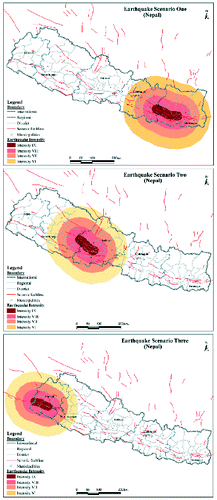
All three earthquake scenarios were considered to generate a maximum of MMI IX level of shaking based on the 1934 Bihar–Nepal earthquake, while the depth and magnitude were not considered in this analysis. As the level of shaking may differ with the distance from the epicentre, it is assumed that about 25% of the total affected area falls in an intensity range of MMI IX to MMI VI.
The earthquake scenario damage to school buildings is estimated on the basis of vulnerability analysis and loss estimation conducted for Lamjung district, Nawalparasi district, Kathmandu valley and some schools of Humla district during the three earthquake scenarios.
As for the methodology, the structural assessment part of the guidelines prepared by Guragain et al. Citation(2004) and DUDBC Citation(2009) was extensively adopted for shaking intensity (MMI VI–IX) and damage grade for different classes of the school buildings. illustrates the shaking intensity and damage grade for various kinds of school buildings under consideration.
Table 4. Shaking intensity (MMI VI–IX) and damage grade for different classes of buildings considered in this work.
It is estimated that more than 9000 school buildings, which is more than 10% of the total school buildings in Nepal, would suffer partial to complete collapse resulting in very high casualty. shows the overall school building vulnerability at the national level if all schools were to be hit by an MMI IX level of shaking. In this figure, DG represents damage grade. It was found that about 40% school buildings lie under a damage grade of five (DG5) at an intensity of IX. Similarly, 35% are of DG4, 21% of DG3 and 4% of DG2. Although it is not expected that all parts of the country would be affected at the same time, the above results would help in developing a vulnerability reduction program at national level. The vulnerability of the school buildings in a single earthquake scenario in any part of the country reveals that only about one-third of the territory of Nepal will be affected.
Furthermore, if we consider potential reconstruction after an earthquake, about 12% of the total school buildings in Nepal (potential DG4 and DG5) will require reconstruction, with the remaining schools requiring retrofitting.
assumes an earthquake damage scenario of all the buildings suffering MMI IX level of shaking. Similarly, from the analysis presented in , it is understood that about 75% (DG4 and DG5) of the schools need intervention. Among them, 60% require retrofitting and approximately 15% require demolition and reconstruction. The potential national level casualty rate in a school is based on the realistic earthquake scenario assumed, as shown in and calculated in terms of potential damage to school buildings based on the vulnerability studies of selected districts of Nepal. If the earthquake scenario were to occur during school hours, there would be more than 110,000 deaths and about 300,000 serious to moderate injuries. gives the details of estimated casualties during an earthquake scenario. The models defined by Coburn and Spence Citation(1992) and as described in RADIUS Citation(2000) were used to estimate the number of casualties, in this table. Flow chart of casualty estimation is presented in .
Table 5. Potential numbers for school buildings affected by a single earthquake scenario.
Table 6. Estimated casualty at schools during earthquake scenarios.
6. Preparing public schools for earthquake disaster risks
In a country like Nepal, people are sceptic about interceptive work for earthquake disaster risk management in schools and residential buildings. Similarly, the option of retrofitting a building or demolishing and reconstructing are considered excessively expensive. A study (NSET Citation2000) shows that when structural intervention for reducing existing vulnerability of the school buildings is not considered, in Kathmandu alone, the expected loss in terms of death or injury will be more than 29,000, and in terms of direct building loss, it will be more than 77%, which has been estimated at an economical damage of around US$ 7 million (). The resulting societal trauma, need for rescue and relief, and degradation of life standard would be of unimaginably high scale. By structural intervention, life of children could be saved and the school buildings, as one of the biggest assets of a community, could be protected. Besides, it will also provide an opportunity for social dialogue, increased awareness, preparedness planning and masons’ training, thereby providing an opportunity for replication and hence inculcating a culture of earthquake safety.
Table 7. Comparative evaluation of the benefits of structural vulnerability reduction of school buildings in the Kathmandu valley.
So, to overcome these issues, a comprehensive work for Public SESP has been designed. In fact, the SESP consists of three closely interlaced sub-components: (1) training of technicians/masons, (2) training of teachers, parents and students on earthquake preparedness and preparedness planning and (3) seismic retrofitting or earthquake-resistant reconstruction of public school buildings. The details of each sub-component of the SESP are described in the following sections.
6.1. Technician/mason training
The whole execution of the program is designed as a tool for developing skilled manpower in earthquake-resistant construction practice in local level. In all the processes of seismic retrofitting and reconstruction, engineers of both governmental and non-governmental organizations work with masons showing them the details and explaining the complete procedures of earthquake-safe construction. Particular focus is placed in explaining the meaning of the processes of concrete curing, proper reinforcement details, what earthquake-resistant elements do, how the retrofit elements, such as splints, bands, corner pins, etc., function to withstand the earthquake force, etc.
Besides the training in the form of explanation, separate training classes are organized in the evenings. The main target groups are the craftsmen of the respective areas and villages, but the classes are typically open to all interested, even for local people. The technical knowledge of earthquake-resistant construction is given to them systematically. Participation of villagers and craftsmen are always higher than the number of masons directly involved in the construction process in the village. This is due to the raised level of earthquake awareness. They have seen their future in this ‘modern’ technology that they should be equipped with. Participants were very enthusiastic. Obviously, the local people, during the various training sessions, exhibited a huge concern over matters like how their own houses are built and over the weaknesses of the prevailing construction practices. Masons paid much attention to know about for and against the aspects of their conventional practices, need to adopt new methods, extent of change, solution to problems that the change may bring about and its harmony with the seismic retrofitting and reconstruction of school buildings, which they witnessed. It is noteworthy that once trainees were convinced and equipped with seismic resistant techniques, they also asked the methodology to convince and teach others about it.
The training courses follow a hierarchical procedure starting from problem identification to end at testing of methods learned. Several tests were conducted to support the knowledge in relation with the effect of placement of a reinforcement rod in beam/slab, quality of work governed by material and workmanship like excess water effect, curing effect, etc. Local masons could well understand the language of retrofit, earthquake-resistance design and the importance of quality control.
More than 2000 masons from various school communities of Nepal have already been trained in the skills of seismic retrofitting, earthquake-resistant construction and quality control. Few of these masons have been trained to be the trainers. In fact, these trainers are given the responsibilities of supervising the construction works at different schools under the program. Based on the experiences gained from the mason training, a curriculum/guideline for mason training has also been prepared.
6.2. Earthquake awareness program and publications
The SESP was implemented with maximum participation by the government institutions (such as the Ministry of Education and DEOs), District Development Committees and Village Development Committees, the School Management Committees, non-governmental organizations, parents and students. The government agencies provide funds and policy guidance, while the actual implementation of construction works is handled by the school management committees with technical inputs and supervision. Such implementation mechanism, together with the formation of central-, district- and school-level advisory committees, considerably widened the outreach of the program and its ownership. All this has resulted in greater awareness of the communities on earthquake disaster risks and risk reduction. It is seen that, nowadays, new constructions in the settlements surrounding the schools have also been incorporating seismic-resistant elements, mostly by consulting the SESP masons. A strong replication potential of the program concept, and hence sustainability of efforts, is thus evident.
Providing training to students and teachers on earthquake preparedness was one of the major and most effective programs. During the project period, any of the activities conducted at the district or local level were considered as an opportunity to make more people aware of disaster safety.
The orientation program consisted of understanding the existing earthquake vulnerability, its reduction measures, personal and collective safety and preparing for the emergency. Many teachers and students were provided training on earthquake preparedness. It includes information provided on the earthquake disaster risks, risk-reduction measures, earthquake preparedness (), response planning of schools, earthquake drill procedures and a mock drill. The number of teachers who underwent the training is more than 2000 including the training received through principals’ workshop. More than 10,000 students participated in the earthquake awareness trainings.
Figure 8. Awareness lectures to teachers, students and technicians on earthquake safety and earthquake-resistant building construction.
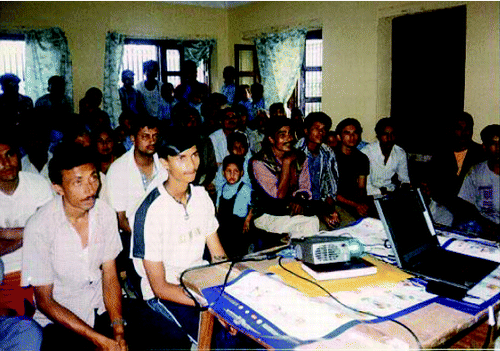
Also, each school was provided with the assistance to prepare emergency preparedness and response plans. For this purpose, six schools were chosen from selected districts and they were asked to prepare emergency preparedness and response plans through the assistance of experts. The plans were developed in association with the school management committees, teachers and senior-grade students. Some of the parents were also involved in preparing the plans. These schools now conduct regular earthquake drills and improve their plans after proper evaluation. All the schools have managed to get basic first aid items to respond during an emergency. The demonstration of light search and rescue of victims is performed during every drill. Few booklets are also published for students, to give enough information about a disaster and how to live with it.
6.3. Retrofitting practice
Based on the results of the school survey, the seismic performance of about 75% school buildings in Nepal must be enhanced. In general, two options are available for seismic performance enhancement of the school buildings in Nepal: (1) demolish and reconstruct and (2) retrofit. This work makes a comparative evaluation of these two options. The first option of ‘demolishing and reconstructing’ by adopting seismic guidelines is easy from a technical point of view, and is also attractive, but there is very high excitement, societal impact and opportunity to learn more in the second option of ‘retrofit’ (). On the economic ground also, the first option is far more expensive than the second (). It is not only costly but the magnitude and duration of disturbance to the existing school functions will also be very high in the demolishing and reconstructing procedure (i.e. more than 1 year in comparison to 3–4 months in the retrofitting option).
Table 8. Comparison between retrofit and reconstruction options.
Table 9. Comparison between retrofit and reconstruction costs (as of 2012, 1, US$ 1 = NRs. 85).
A quantitative evaluation of the effectiveness of seismic retrofitting was done by subjecting two identical brick masonry buildings in mud-mortar to a pull-down test. This typology of the buildings was similar to most of the selected school buildings in this study. The model pulldown test of the identical buildings (retrofitted and non-retrofitted) suggested that the mud–mortar non-retrofitted building collapsed in 17 ton of the pulldown loading as compared with the numerically predicted 18.22 ton of the loading. A similar building was retrofitted with 16-gauge galvanized iron (GI) wire meshing on both faces of the walls with 1:3 cement sand mortar. The retrofitted building tested with 1.55 times the pulldown load compared with the similar non-retrofitted building without any visible cracks. Finally, it was concluded numerically and experimentally that the capacity of the existing school buildings can be increased up to a desired value with proper designing.
As for the fragility curves for different types of school buildings, the curves available in the Nepal National Building Code (NBC Citation1994) were modified as shown in . As the school buildings are designed for minimum life safety level of damage at MMI IX level of shaking, it was assumed that the retrofitted school buildings may be safe at minimum DG3 level of damage in MMI IX.
Figure 9. Fragility curves for different types of buildings (NBC Citation1994).
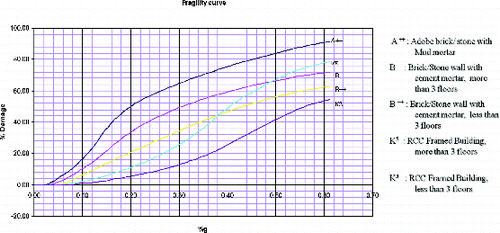
A national experts’ workshop was held in 2010 to realize the first implementation approach. The workshop recommended that the program should first be implemented from the Kathmandu valley because the seismic risk of the Kathmandu valley is the highest among the mega cities of the world. Similarly, in case of an equivalent shaking as in the 1934 Bihar–Nepal earthquake, estimations of more than 100,000 casualties, 200,000–300,000 injuries and more than 60% building collapses were made in the Kathmandu valley. Of this, more than 29,000 deaths and around 40,000 injuries were estimated due to poor school infrastructures and low level of emergency preparedness in schools. Due to the population density of the city, casualties during an earthquake will be the highest in the Kathmandu valley. Since retrofitting is still a new practice and there are very few sufficiently trained engineers, technicians and masons in this field, the first phase is an opportunity to begin training the professionals in Kathmandu. Similarly, the technical human resources required can be developed during implementation of the program in the Kathmandu valley. In the meantime, the Department of Education (DOE) can train their engineers during assessment, design and retrofitting. Management capability of the department can also be enhanced during the initial phase of implementation in the valley to ensure the implementation in other parts of the country in a smoother manner. The work in Kathmandu surely helps to build up confidence of the government and other implementation agencies, and also the experience gained in Kathmandu can be replicated in other parts of the country. Moreover, successful implementation in Kathmandu can attract international donor agencies to fund similar programs in other districts of the country. Likewise, people of other parts of the country will have a tendency to copy the things being implemented in the Kathmandu valley. Hence, this was an opportunity for the government to create awareness and disseminate the importance of disaster risk reduction nationwide. The first implementation in Kathmandu also helped to explore different techniques, to improve the previously developed techniques and to adopt appropriate techniques of retrofitting where and when needed. Since retrofitting is a relatively new practice in Nepal, specific norms for different components are not available yet. While implementing the retrofitting program in the valley, certain norms and associated costs are also worked out.
6.3.1. School retrofitting in Kathmandu valley and Nawalparasi district
After assessing the earthquake safety of the school buildings, some guidelines were prepared and pilot retrofitting works were carried out in the Kathmandu valley and Nawalparasi district to enhance the SESP. These pilot works are basically targeted to disseminate information about earthquake safety of the school buildings. In selecting appropriate school buildings for retrofit, various aspects such as location, typology, age, visibility, community participation, number of students and the impact in awareness are considered. The following criteria were used for selection of schools in initial stage of retrofitting in the Kathmandu valley.
Schools from the valley where the maximum intensity of the earthquake, as in 1934, was observed.
Schools from the core city areas of the valley where an easy evacuation space is not available and the environment outside the school premise is not favourable (such as narrow streets, densely populated and vulnerable buildings on the way to evacuation space, etc.).
Relatively old buildings with unbalanced load paths, higher number of stories and bigger spans of rooms.
School buildings constructed with low-strength materials, such as sun-dried bricks and mud, brick or cement in mud and so on.
Schools prone to other hazards, such as landslides.
Vulnerable masonry school buildings, masonry buildings of poor construction, poor configuration and those constructed without following the building code.
RCC-framed structure buildings constructed without the guidelines of the DOE (inadequate size and strength of structural elements, more than permissible number of stories).
Day-to-day visibility of the school in community to create awareness.
The DOE is the main implementing agency of the Public SESP. It is responsible for overall program management including financial support, technical human resources and monitoring and evaluation of the program.
A central-level steering committee, comprising high-level officials from various related authorities, is also formed to provide guidance and supervision of the implementation of the program. At the same time, a high-level technical committee is formed to provide guidance in technical matters including reviewing and verification of designs and detailing.
A survey of all the existing school buildings is required for assessing the vulnerability levels and to estimate the actual cost and other necessary resources. Initial visual surveys are conducted through a structured checklist, which is filled out for each building. These checklists are filled out by the teachers after attending an orientation program. Technical personnel of the DEO provide technical guidance to the teachers and resource persons and monitor the work done by the teachers of each school. Filled out forms are collected at each DEO through the respective resource persons of each resource centre. All documentation and analysis are done and sorted for each district. However, certain data and results, such as the number of school buildings and number of school buildings to be retrofitted and/or reconstructed, are sorted by the resource centre. The results helped in planning and implementing the activities in each resource centre.
Detailed assessment and design for retrofitting is done for each building unit, but grouping of similar building types is also done while implementing on a mass scale. Grouping is done after assessing a certain number of buildings. It helps to reduce the amount of time and money for detailed design significantly, which results in reduced number of trained professionals for design. Possible grouping mechanism is as follows:
similar types of materials and construction technology;
similar number of storey;
span limit;
similar vulnerability factors;
certain floor area
Typical retrofitting techniques with standard designs are developed for general cases with specific details prepared on the basis of design requirements for structural safety. The cost of each building is calculated separately. For a multi-hazard approach, costs of other mitigation measures and extra intervention are calculated and included in the estimated cost. Assessment and design is based on a multi-hazard approach. Mitigation measures for other site-associated hazards, including landslides, inundation, flash floods, fire and high wind, are also incorporated in the design and cost estimates of each individual school.
There are a number of different technologies for seismic retrofitting, based on the type of construction and vulnerability condition of the building. However, the applied technology is appropriate in the Nepalese context, which encourages the use of locally available materials and the involvement of local human resource. While achieving the primary goal in enhancing the level of safety of the structure, the applied technology has a potential of replication in other buildings giving an opportunity of skill enhancement and training of the masons involved. The following are commonly employed techniques for load-bearing structures:
RCC splint and bandage technique,
RCC jacketing on both faces of the walls with steel reinforcement,
jacketing on both faces of the walls with GI wire mesh,
combination of jacketing and splint and bandage with steel or GI wire mesh,
jacketing with gabion wire mesh on both sides (for low-strength masonry buildings with stone and mud),
timber splints and bands for RCC-framed structures,
introduction of shear walls,
jacketing of columns and beams,
foundation underpinning,
strengthening of infill walls with RCC bands.
The techniques and detailed procedure of intervention were worked out during design and after detailed assessment of each individual building. Implementation of retrofitting works goes beyond merely making the building stronger, assisting schools to prepare for better response during and after an earthquake. It therefore comprises the following activities along with the retrofitting:
supervision of retrofitting work,
quality assurance,
awareness training to students, teachers and parents,
preparation of earthquake preparedness and response plan,
conduct earthquake drill.
lists the number of school buildings to be retrofitted by the community and graded contractors in the whole of Nepal. Out of 700 school buildings to be retrofitted, approximately 140 school buildings are to be retrofitted in the Kathmandu valley through specialized contractors. Most of these buildings are relatively larger in size and multi-storeyed RCC-framed structures, although some are historically important and require highly technical expertise and equipment. Since the community and School Management Committee have little to no capacity in implementing the retrofit of such structures, specialized contractors are preferred in this case.
Table 10. Tentative numbers of schools in Nepal which are going to retrofit for 2012–2016.
and show some photographic evidences of the retrofitting work. After the experience in the Kathmandu valley, one school of Nawalparasi district was also retrofitted (). Since most of the schools were built through community initiation, retrofitting was also implemented through community mobilization wherever possible. A community-involved mechanism helped to reduce the cost of retrofitting/reconstruction as locally available materials were provided at a subsidized rate. The implementation period was a little longer because the community mobilization only took place briefly during their free time/season. Involvement of the community, however, was essential for a successful implementation of the program, which ensured a feeling of ownership by the community.
Figure 10. Retrofitting works in the building of Adarsh Secondary School in Bhaktapur district, Kathmandu valley: (a) is before retrofitting, (b) is during retrofitting works (jacketing on the wall with steel reinforcement) and (c) is after completion of retrofitting.
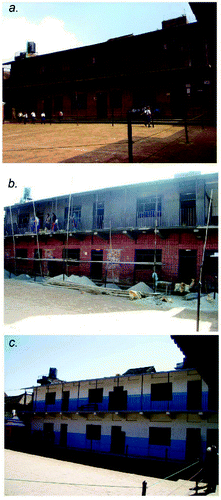
Figure 11. Retrofitting of school buildings in progress: (a) Gorakhnath Secondary School, Kirtipur, Kathmandu (jacketing on the wall with steel reinforcement), (b) Janaudah Lower Secondary School, Lalitpur district, Kathmandu valley (close view of steel reinforcement placing), (c) Chundevi Higher Secondary School, Kathmandu (steel reinforcement anchoring to the wall), (d) Saraswati Secondary School in Thecho, Lalitpur district, Kathmandu valley (micro concreting after steel reinforcement).
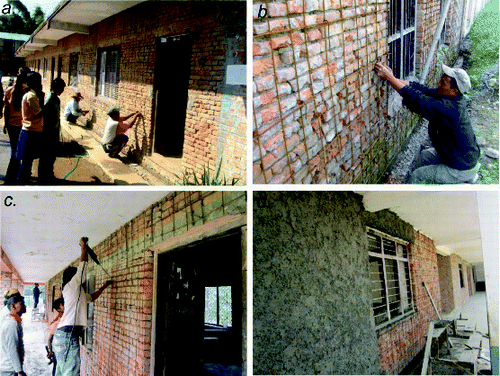
Figure 12. School retrofitting in Nawalparasi district. (a) Community is inspecting the retrofitting work. (b) Retrofitting work by splint and bandage method in progress.
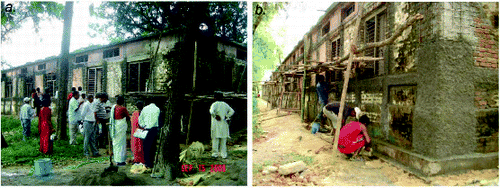
The management of required materials, construction workers, community mobilization in construction/retrofitting, awareness programs and school emergency planning was done by the school, in association with the parents and local people. The School Management Committee was also responsible for the day-to-day supervision of the work and continuation of the school preparedness in future. All financial and technical aspects of the project were made transparent and a monthly statement was made public. Technical professionals and an expert committee of professionals assisted the school and community throughout the implementation of the program.
7. Visible impact of SESP
Although a direct impact survey was not conducted in this work, many changes have been noticed both in community and implementation sectors. Major visible impacts of the SESP are described in the following sub-sections.
7.1. Impact in the concept of line agencies
Although many of the indirect impacts cannot be observed visibly, in the initial period, officials at the DEO and school resource persons were enthusiastic about school earthquake safety. However, the attitude changed conspicuously following their engagement and participation in the series of interaction and orientation. They have internalized the earthquake risk and realized the need for school safety. The DEOs of all selected districts provided continuous support to the training, awareness and school retrofitting process, although it was not as part of their regular program.
7.2. Attitude change in teachers and students
After the SESP, awareness level of teachers and students has increased. Many schools have also been conducting earthquake drills on a regular basis since the beginning of SESP.
7.3. Attitude change in masons
Masons have also started to implement earthquake-resistant construction techniques in their communities. They have even started to suggest that local people construct new houses incorporating earthquake-resistant construction techniques.
7.4. Changes in neighbourhood schools and communities
Many schools in neighbouring areas have requested the National Society for Earthquake Technology (NSET), Kathmandu for technical assistance after they learned about the program activities, attended the earthquake orientation programs and visited the nearby retrofitted schools. Engineers involved in SESP usually provide such assistance by reviewing the design, providing practical guidance during construction and conducting earthquake orientation and training programs in the vicinity of the schools. The people in the districts and nearby communities are now well aware of the aspects of earthquake safety and this has become one of the most talked topics in their free time. Awareness level among the school's family and the community regarding earthquake safety and skills of keeping themselves safer is now increased.
It was also noticed that in most of the places, people have lesser interest in community work but their participation in school safety activities is really encouraging.
7.5. Concept for curricula development
Now the government agencies have understood that earthquake disaster safety needs to be addressed and incorporated into formal curricula at all levels of school education. They have also realized that earthquake safety needs to formalized and institutionalized into a regular national program as one of the development initiatives.
7.6. Resource person in lead role
In Nepal, each and every school has the provision of a resource person and he or she will respond to help teachers of few schools of surrounding areas for various teaching materials and required training. During the implementation of SESP in selected schools, it was realized that resource persons can play a significant role in providing orientation to the teachers, disseminating knowledge and information to schools and monitoring the school activities. Thus, it will be very effective if they are trained and given the responsibility of awareness, raising and educating the school family about earthquake safety.
7.7. Lesson learned
After implementing SESP in the selected districts, some lessons have also been learned. It is understood that any effort in raising earthquake awareness always pays. It pays more if the effort is pervasive from the central to the local level. From the survey and analysis, it was found that a majority of the school buildings are vulnerable and schools face extreme seismic disaster risk. Unless there is a nationwide comprehensive earthquake safety program for school safety and its timely implementation, there will be a huge casualty and destruction. It was also realized that local masons do not have adequate capacity to implement designs of earthquake-resistant buildings as provided by the DOE. Unless the capacity and skills of local masons is enhanced, the desired quality and safety of construction cannot be achieved. It was also understood that the funding provided by the government to the schools for construction is insufficient to complete the construction in desired quality and time. Hence, it further contributes to increased vulnerability of school buildings. There is a provision of funding for small-scale repair and refurbishment of school buildings, which covers most of the schools in a district. If this amount is utilized in retrofitting the vulnerable school buildings, although less in number, the existing risks can be reduced significantly. Moreover, there is limited capacity of engineers and technicians on building assessment, design and implementation of retrofitting work. It is necessary to enhance their capacity through intensive as well as practical trainings. In many cases, the school family does not have an understanding of the importance of earthquake preparedness and emergency planning in schools. These things are new to them, but after an orientation program they were found to be very positive towards preparing plans and conducting drills once they were provided orientation. For this reason, a general orientation on emergency planning and conducting drills should be provided to all schools.
8. Concluding remarks
In Nepal, studies of the earthquake catalogue indicate that a devastating earthquake is inevitable in the long term and likely in the near future. Towards building earthquake-safe communities in Nepal, the Public SESP is recognized as one of the most effective programs. This paper discussed a few important issues in relation to this program through the introduction of primary materials used in constructing the school buildings, building typologies, factors affecting school building construction and their vulnerabilities, possible retrofit schemes and various factors affecting the cost. The paper also argued why it is absolutely necessary to implement retrofit intervention and discussed the available incentives for retrofitting the school buildings and future strategies for such interventions. It further elaborates the likely consequences if no intervention is made.
The knowledge, program, technology and training to be given to the community under the SESP were compatible to what they accept and practice. It implies that the community-based approach should start from sustainable and reliable low-cost technology options for mitigation and preparedness so that people not only understand the logic, but also accept and use it. SESP consistently adopted simple technical approaches, which made the SESP initiatives cost effective and understandable to the laypersons. SESP has been accepted by governmental and non-governmental sectors and is now being replicated by the related communities worldwide because of its comprehensive approach.
The SESP helped much to convince the local government, people and local political leaders also on the affordability and possibility of constructing earthquake-resistant public school buildings using slight improvements in the locally employed methods of construction.
Acknowledgements
This paper is an outcome of the last 20 years of work experience in the field of SESP and is based on the work done by NSET. All research staffs of NSET are acknowledged for their technical support during the preparation of this paper.
References
- Ambraseys N, Bilham R. 2000. A note on the Kangra Ms = 7.8 earthquake of 4 April 1905. Curr Sci. 79:45–50.
- Arnold M, Dilley M, Deichmann U, Chen RS, Lerner-Lam AL. 2005. Natural disaster hotspots: a global risk analysis. Washington, DC: World Bank Hazard Management Unit; 132 p.
- Bilham R. 2001. Slow tilt reversal of the Lesser Himalaya between 1862 and 1992 at 78 deg. E, and bounds to the southeast rupture of the 1905 Kangra earthquake. Geophys J Int. 144:713–728.
- [BCPR] Bureau for Crisis Prevention and Recovery. 2004. Global report – reducing disaster risk, a challenge for development. Geneva: United Nations Development Program. Bureau for Crisis Prevention and Recovery; 10 p; [cited 2012 Dec 1]. Available from: http://www.un.org/special-rep/ohrlls/ldc/Global-Reports/UNDP%20Reducing%20Disaster%20Risk.pdf.
- Chitrakar GR, Pandey MR. 1986. Historical earthquakes of Nepal. Bull Geol Soc Nepal. 4:7–8.
- Coburn A, Spence RJS. 1992. Earthquake protection. New York, NY: Wiley; 355 p.
- [DUDBC] Department of Urban Development and Building Construction. 2009. Seismic vulnerability evaluation guideline for private and public buildings, Part I: Pre-disaster vulnerability assessment. Kathmandu: Department of Urban Development and Building Construction, Government of Nepal; [cited 2013 Feb 4]. Available from: http://errrp.org.np/document/study_report/Seismic%20Vulnerability%20Evaluation%20Guideline%20Part%20I-final.pdf.
- Dunn JA, Auden JB, Gosh AMN, Roy SC. 1939. The Bihar-Nepal earthquake of 1934. Mem of Geol Surv India. 73:391 p.
- [GHI] GeoHazards International and [UNCRD] United Nations Centre for Regional Development. 2001. Global Earthquake Safety Initiative Pilot Project Final Report; 86 p; [cited 2012 Dec 1]. Available from: http://www.preventionweb.net/files/5573_gesireport.pdf.
- Gupta SP. 1988. Eastern Nepal earthquake 21 August 1988, damage & recommendations for repairs and reconstruction. Bangkok: Asian Disaster Preparedness Center, Asian Institute of Technology.
- Guragain R, Jimee G, Dixit AM. 2008. Earthquake awareness and effective planning through participatory risk assessment: an experience from Nepal. The 14th World Conference on Earthquake Engineering; 2008 October 12–17; Beijing; 8 p.
- Guragain R, Pandey B, Shrestha S. 2004. Guideline on seismic vulnerability assessment of hospitals in Nepal. Kathmandu: NSET; 114 p.
- [JICA] Japan International Cooperation Agency and the Ministry of Home Affairs of Nepal. 2002. The study on earthquake disaster mitigation in the Kathmandu valley, Kingdom of Nepal. Kathmandu: Japan International Cooperation Agency and the Ministry of Home Affairs of Nepal, Vol I, II, and III.
- [NBC] National Building Code. 1994. Nepal National Building Code. Nepal: Ministry of Physical Planning and Works.
- [NSET] National Society for Earthquake Technology. 2000. Seismic vulnerability of the public school buildings of Kathmandu valley and methods for reducing it: a report on the school earthquake safety program of the Kathmandu valley earthquake risk management project. Kathmandu: NSET.
- [RADIUS] Risk Assessment Tools for Diagnosis of Urban Areas Against Seismic Disasters. 2000. A CD ROM on risk assessment tools for diagnosis of urban areas against seismic disasters – an initiative of the International Decade for Natural Disaster Reduction (IDNDR). Geneva: Secretariat of the International Strategy for Disaster Reduction (ISDR).
- Raghukanth STG, Kumari KL, Kavitha B. 2012. Estimation of ground motion during the 18th September 2011 Sikkim earthquake. Geomat Nat Hazards Risk. 3(1):9–34.
- Rai DC, Mondal G, Singhal V, Parool N, Pradhan T, Mitra K. 2012. Reconnaissance report of the M6.9 Sikkim (India–Nepal border) earthquake of 18 September 2011. Geomat Nat Hazards Risk. 3(2):99–111.
- Rana BJB. 1935. Nepal ko maha bhukampa [Great earthquake of Nepal]. Kathmandu: Jorganesh Press.
- Shrestha HM. Forthcoming 2001. Construction management for earthquake risk reduction works in schools of Kathmandu valley. [A thesis submitted to the M. Sc. Program in Construction Management]. Nepal: Nepal Engineering College, Pokhara University.
- Wyss M. 2005. Human losses expected in Himalayan earthquakes. Nat Hazards. 34:305–314.

